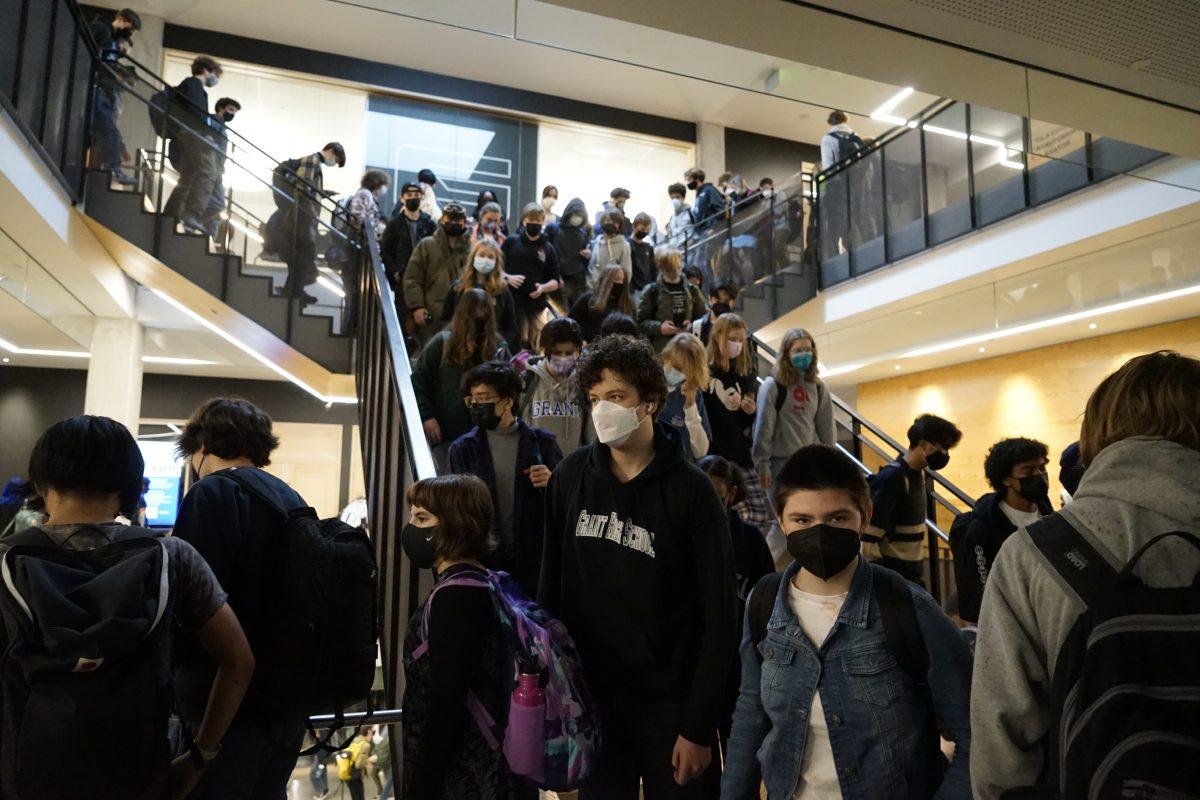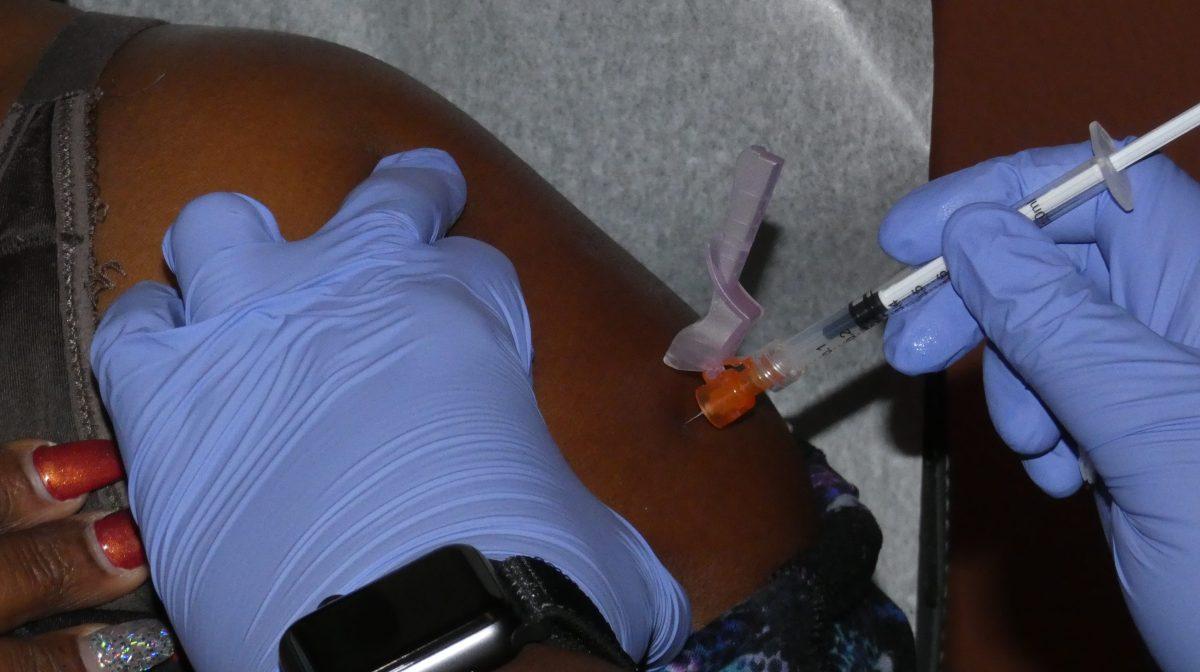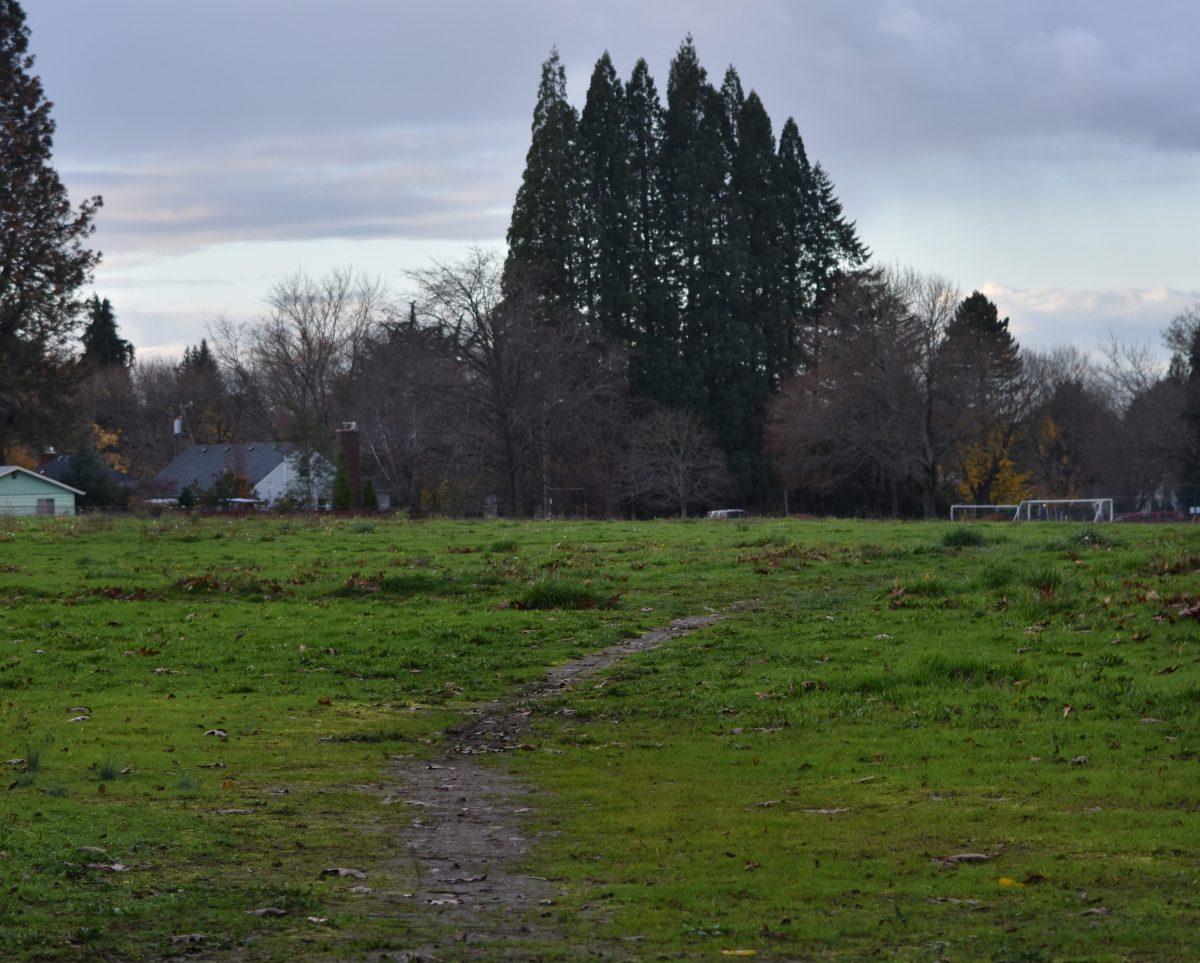Every day, nearly 2,200 students flood the halls of Grant High School, shuffling shoulder-to-shoulder up staircases and packing into too-small classrooms. A sign that reads, “Please observe the 3ft social distance rule” sits unheeded in the foyer. Grant junior Charlotte Saal says that she “can’t even move through the ocean of kids,” on the main staircase. Social distancing and the district’s other COVID-19 precautions are ignored out of necessity.
The school building is 500 students over capacity, and these enrollment issues aren’t unique to Grant.
High schools across Portland are experiencing overcrowding. The district has tried to alleviate the issue through both long-term solutions and short-term patches, none of which have been completely successful. The high student population combined with the physical limitations of PPS buildings, even after renovations, make physical distancing impossible. While projections estimate that enrollment will eventually decrease, schools like Grant could contend with overcrowding into at least the 2024-2025 school year.
Judy Brennan, the PPS director of enrollment and transfer, says that every PPS high school, save for the recently-modernized McDaniel, is operating at or over capacity. PPS records show that Jefferson also has available capacity.
Today’s overcrowding was caused by an influx of students entering the Portland Public Schools system in the early 2010’s. “We had some large cohorts of students enter eight to 10 years ago, like roughly more than 4,000 students entering Kindergarten in the span of a few years,” says Brennan. “Those kids are still moving through the system and are now high schoolers.”
These high enrollment numbers will eventually subside as smaller middle and elementary school populations make their way to high school. “The cohorts that have come through more recently have been closer to below 3,500 down to like 3,200, 3,000,” Brennan says.
Dual Assignment Zones have made it so this surplus of high school students is unevenly distributed across district schools. Dual Assignment Zones are areas where students have the choice to attend one of two neighborhood high schools.
Jefferson High School’s student population comes from three Dual Assignment Zones: a joint Jefferson/Roosevelt zone, a joint Jefferson/McDaniels Zone, and a joint Jefferson/Grant zone. 31% of Grant’s student body lives in the Jefferson/ Grant Dual Assignment Zone. The large number of students who select Grant over Jefferson cause Grant to be overcrowded and Jefferson to be underutilized.
The district attempted to prevent unbalanced enrollment through boundary changes. For the 2018-19 school year, PPS opened Harriet Tubman as a six-eight middle school and converted former K-eight Roseway Heights into a six-eight middle school. This was to accommodate a then-growing middle school population and balance district enrollment. Establishing high school feeder patterns for these new middle schools was seen as an opportunity to balance high school enrollments.
The opening of Harriet Tubman and the accompanying redrawing of district boundaries moved nearly 500 students from the Grant feeder boundary into an expanded Jefferson/Grant Dual Assignment Zone.
Despite the new opportunity for these students to attend Jefferson, the majority continued to select Grant. The year after the boundary change went into effect, Grant enrollment from the Grant/Jefferson dual enrollment zone increased by 468 students, while Jefferson enrollment from the zone only increased by 26 students. Even after this boundary change, Grant remains overcrowded and Jefferson remains under capacity.
The way that PPS high schools have been renovated accentuates the issue. During the November 2013 planning process for the PPS School Building Improvement Bond Program, the school board decided that all renovated PPS schools would hold a maximum of 1,700 students. That number was based on enrollment projections at the time, which vastly underestimated the number of students who would eventually attend Grant and Franklin. Now, both are currently at least 400 students over capacity.
Even though smaller schools like Roosevelt have historically held fewer students than Grant and Franklin, parents and teachers at school board meetings successfully argued for each renovated school to hold the same amount of students.
This advocacy was likely because, as PPS said during planning for boundary changes, “The amount of funding your school receives is based mostly on the number of students (enrolled).” Because enrollment impacts budgeting, having fewer students can potentially limit the programs that a school can offer.
This is especially difficult for schools with available capacity, where the majority of students tend to already be in underserved groups. For under-capacity McDaniel and Jefferson high schools, 65.3% and 75.6% of their student bodies respectively are either in Special Education, on Free or Reduced Lunch, with limited English proficiency or belong to an underserved racial, ethnic or ancestral group. By comparison, 26.7% of the Grant population is composed of these groups.
The trade-off with constructing all high schools at equal size, though, is that enrollment trends don’t necessarily line up with a school’s building capacity. The size of more popular schools are artificially capped, and as a result, some renovated buildings like Grant are left overcrowded.
“I question the idea of modernizing these buildings for a max of 1,700 students,” says Grant principal James McGee.
At Grant, this capacity has led to a shortage of classrooms.
William Wilson, an AP and NGSS Chemistry teacher, says that overcrowding has made his job noticeably more difficult. “When you have classes this big, you’re really in survival mode.”
He describes having to rework the curriculum to be both COVID-19 friendly and to accommodate more students.
Wilson feels that the district has not been supportive of staff as they navigate massive class sizes and workloads. “I feel like there’s no acknowledgement from central administration. The way they allocate resources when you see these enrollment spikes doesn’t really translate to resources in the building to mitigate the overcrowding and large classes,” he says.
Principal McGee says the opposite—that the district has been supportive in alleviating issues of overcrowding. He provided one example of a way in which the district has supported the school with overcrowding, and it is actually not a reality yet. “I told them, ‘If we’re gonna use the forums for classrooms, I need cushions.’ Those are cement, and that can be challenging for anyone to sit on for an hour and a half,” he says.
Despite this, the forums are not currently being used as classrooms and do not have cushions.
Wilson has also felt a loss of important student-teacher connections. “I pride myself on trying to get to know my students, but when you have so many people, you just can’t have the capacity to get to know everyone,” he says.
Russell Peterson, a social studies and psychology teacher, expresses a similar sentiment. “When I have such large numbers it’s really really hard to get to know my students individually.” Peterson feels that overcrowding has driven down the quality of instruction and education. “Students are not getting what I think they deserve,” he says.
This is also felt by students. Saal says, “When there’s 30 to 40 kids in my class my teacher can’t get to everyone, answer all the questions or help with work … It honestly feels like I got a better experience online, because I could email my teacher and they’d actually have to answer it, instead of in- person school, where I’m sure they get so many emails.”
Faculty members and students across Grant have been affected by overcrowding- related issues. A lack of available classrooms has pushed Kazuko Page, a Japanese teacher, and her students into the library.
Page teaches students in the Japanese Magnet Program (JMP), an immersion program that only Grant offers. JMP students account for about 14% of Grant’s student body. Only 10% of the program actually lives in the Grant neighborhood, with most coming from southeast Portland, where Richmond Elementary and Mt. Tabor middle school, the JMP feeder schools, are located.
Around November of 2020, there was a plan proposed to move the JMP students to McDaniel High School in order to alleviate overcrowding. Many JMP students opposed the idea, and created a petition, garnering support from students and teachers outside the program.
“As soon as it gets overcrowded, instead of cracking down on the borders they would instead just like send us away,” Olivia Yilmaz, a Grant junior in the program says. Yilmaz says that since the petition circulated and gained over 1,000 signatures, she hasn’t heard anything more about the move.
Page says that the program needs to stay at Grant. “We’ve been here since 1998, so we have created a long history here. And by moving, we’re gonna lose that. Also, I feel we have brought diversity into this building which is becoming less and less diverse, so I think it’s important to keep the program like this.”
As of now, JMP remains at Grant.
Grant’s building further exacerbates the issue of overcrowding. The school was modernized and opened to students in 2019, which was a widely-anticipated and celebrated event. However, issues with its design have been made more apparent by the COVID-19 pandemic and overcrowding. For example, the building includes a number of large common spaces. “We have spaces that could be classrooms if they would’ve been built that way,” Wilson says.
The master plan for Grant’s renovation had 81 classrooms. Currently, approximately 100 teachers are employed at the school. This prevents teachers from having their own spaces, which creates a logistical nightmare for staff as they have to pick up and move all of their materials frequently.
Repurposing non-classroom spaces is one of the district’s short-term fixes to overcrowding. “It’s really tough to say that we’ve had to do that in schools that we invested in and modernized. Like the minute we built them, we started, you know, trying to break them up and change them,” says Brennan.
For more overcrowded schools, methods for repurposing space have been largely exhausted. “There are very few options left for Grant,” Brennan says.
PPS has also been more accommodating of students’ transfer requests out of overcrowded schools. “We don’t look as closely at the reason because we know that school is overcrowded,” says Brennan. The district has also cut back on allowing students to transfer into overcrowded schools, like Grant and Franklin.
Despite these attempts from the district, Grant’s staff has been forced to make other concessions to accommodate its large student body.
Tara De Leon, a counselor tasked with balancing student schedules, says, “From the beginning, our job was harder to do, because where are we going to put these kids?” One way the counseling office limited class sizes this year was by making study hall periods larger and more common.
The massive student body also makes following COVID-19 precautions difficult. PPS requires that three feet of distance be maintained between students “when possible.”
At Grant, it is never possible. Classrooms look no different than they did before the pandemic. Students sit shoulder-to- shoulder and hallways are crowded during passing periods. The school’s main stairs are consistently a slow moving stream of tightly packed students, and students fill the foyer before lunch.
In a recent student-organized walkout
pushing for a COVID-19 vaccine mandate,
student speaker Jordan Galloway said,
“We see crowds … every day, congesting stairwells, in the lunch lines, and in the halls.” He says that these crowds reinforce the need for a vaccine requirement for students.
Wearing masks is essentially the only precaution students are realistically able to take because distancing is seldom enforced— out of necessity. COVID-19 safety guidelines are less effective as long as the Grant building is over capacity.
While PPS administration projects that overcrowding in high schools will become less of an issue in coming years, short-term solutions don’t solve the immediate problem for teachers. In the meantime, COVID-19 and large student populations will weigh on staff and students alike. Wilson says, “It’s an incredibly hard year to be a teacher.”♦


































